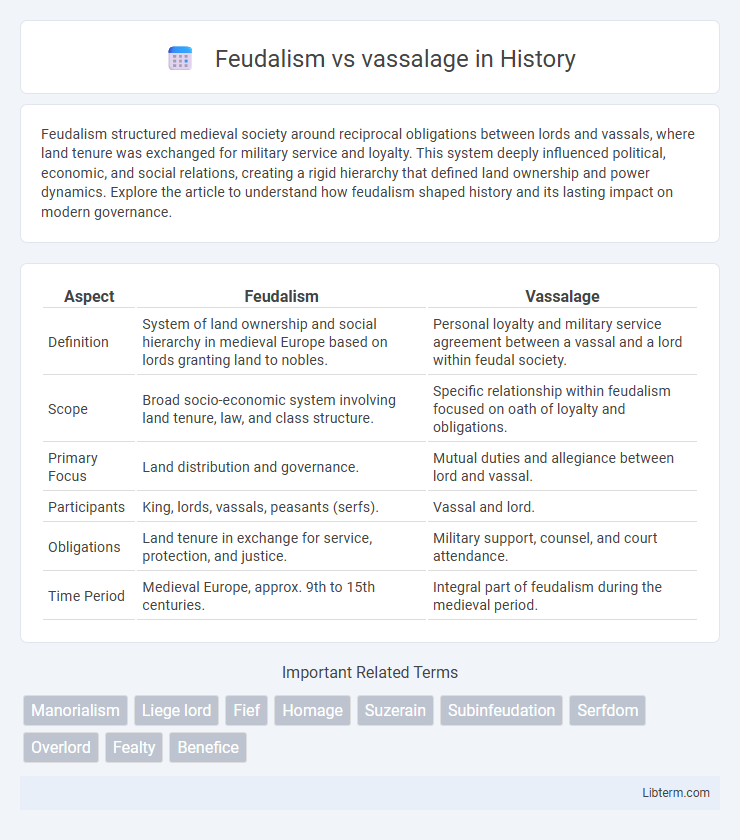Feudalism structured medieval society around reciprocal obligations between lords and vassals, where land tenure was exchanged for military service and loyalty. This system deeply influenced political, economic, and social relations, creating a rigid hierarchy that defined land ownership and power dynamics. Explore the article to understand how feudalism shaped history and its lasting impact on modern governance.
Table of Comparison
| Aspect | Feudalism | Vassalage |
|---|---|---|
| Definition | System of land ownership and social hierarchy in medieval Europe based on lords granting land to nobles. | Personal loyalty and military service agreement between a vassal and a lord within feudal society. |
| Scope | Broad socio-economic system involving land tenure, law, and class structure. | Specific relationship within feudalism focused on oath of loyalty and obligations. |
| Primary Focus | Land distribution and governance. | Mutual duties and allegiance between lord and vassal. |
| Participants | King, lords, vassals, peasants (serfs). | Vassal and lord. |
| Obligations | Land tenure in exchange for service, protection, and justice. | Military support, counsel, and court attendance. |
| Time Period | Medieval Europe, approx. 9th to 15th centuries. | Integral part of feudalism during the medieval period. |
Introduction to Feudalism and Vassalage
Feudalism is a hierarchical social and economic system that dominated medieval Europe, characterized by the exchange of land for military service and loyalty. Vassalage is a key component of feudalism, wherein a vassal pledges allegiance and service to a lord in return for protection and a fief, or land grant. This reciprocal relationship structured medieval society, defining political power, economic obligations, and social order.
Historical Origins and Evolution
Feudalism originated in medieval Europe as a decentralized political system where land was exchanged for military service, evolving from the collapse of centralized Roman authority. Vassalage, a key component of feudalism, developed as a personal bond between a lord and a vassal, formalized through ceremonies like homage and fealty. Over time, these institutions adapted to regional variations, influencing the social and legal frameworks of Europe from the 9th to the 15th centuries.
Core Concepts: Defining Feudalism
Feudalism is a decentralized political system in medieval Europe where land was exchanged for loyalty and military service, structured around the relationship between lords and vassals. Core concepts include the allocation of fiefs, the mutual obligations of protection and service, and the hierarchy linking monarchs, nobles, and knights. Vassalage specifically refers to the personal bond and legal contract between a lord and a vassal, emphasizing loyalty and duty within the broader feudal framework.
Core Concepts: Understanding Vassalage
Vassalage constitutes the central element of feudalism, defining the legal and military relationship between a lord and a vassal, where the vassal pledges loyalty and service in exchange for protection and land tenure. This bond involves mutual obligations: the vassal provides military support, counsel, and various services, while the lord guarantees sustenance and defense. Understanding vassalage elucidates the hierarchical and decentralized nature of medieval political structures, emphasizing personalized bonds over territorial sovereignty.
Structure of Medieval Society
Feudalism structured medieval society through a hierarchy where the king granted land to powerful nobles in exchange for military service, forming the basis of political authority and land ownership. Vassalage was a key component, defining the personal bond and mutual obligations between lords and vassals, including protection, loyalty, and land tenure known as fiefs. This system created a network of allegiances that determined social status, economic duties, and governance across kingdoms in medieval Europe.
Legal Bonds Between Lord and Vassal
Feudalism established a complex system of legal bonds between lord and vassal centered on mutual obligations, where the lord granted land (fief) to the vassal in exchange for military service and loyalty. Vassalage was the personal relationship binding the two parties under oath, creating enforceable duties upheld by medieval courts and customs. This legal framework ensured social order and protection within the feudal hierarchy, emphasizing land tenure as both a privilege and responsibility.
Land Tenure and Economic Relations
Feudalism structured land tenure through a hierarchical system where lords granted fiefs to vassals in exchange for military service and loyalty, establishing a clear economic dependency between social classes. Vassalage, as a personal bond within this system, created reciprocal obligations where the vassal managed the land and collected revenues, while providing economic and military support to the lord. This arrangement formed the basis of medieval agricultural production and local governance, intertwining land ownership with socio-economic rights and duties.
Political Power and Social Hierarchies
Feudalism structured political power through a decentralized system where kings granted land to nobles in exchange for military service, reinforcing a hierarchy of lords and vassals. Vassalage defined specific social and political obligations between a lord and a vassal, emphasizing loyalty and protection within this stratified order. The interplay of feudal land tenure and vassal relationships entrenched rigid social hierarchies, consolidating regional control under interconnected noble families.
Differences and Similarities Between Feudalism and Vassalage
Feudalism is a broad socio-political system characterized by the exchange of land for military service, while vassalage specifically refers to the personal relationship between a lord and a vassal involving mutual obligations and loyalty. Both feudalism and vassalage rely on hierarchical structures and land tenure, but feudalism encompasses the entire societal framework, whereas vassalage centers on the contractual bond within that framework. Key differences include the scope--feudalism governing overall political order versus vassalage as a component of feudal relations--and the focus on personal versus systemic duties.
Lasting Legacy in Modern Societies
Feudalism established hierarchical social structures that influenced modern governance systems and property rights, embedding concepts of mutual obligations between lords and vassals into legal traditions. Vassalage specifically contributed to the development of contractual relationships and loyalty-based allegiances, which persist in contemporary organizational and political frameworks. The lasting legacy of feudalism and vassalage is evident in modern notions of duty, service, and decentralized authority within nation-states and institutions.
Feudalism Infographic

 libterm.com
libterm.com